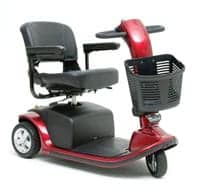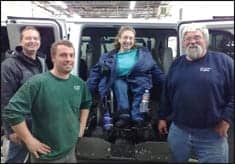 |
| The Jazzy Select, by Pride Mobility Products. |
When it comes to power mobility devices (PMDs), there is both good news and bad news for patients. The good news is that PMD technology is better than ever with smart features such as infrared controllers and enhanced tracking to improve quality of life for users. The bad news is that reimbursement cuts and the specter of competitive bidding may significantly limit beneficiary access to these new features.
“There are fantastic technologies available on the market, but by and large, the Medicare beneficiary doesn’t have access to it,” says Laura Cohen, PhD, PT, ATP, owner of Rehabilitation & Technology Consultants in Decatur, Ga. “So, even though these technologies have great applications to help people live independently, improve quality of life, and return to work, people don’t have access to it.”
Most payors take their reimbursement cues from Medicare. As a result, finding a PMD that fits both a patient’s needs and budgetary constraints is a constant challenge. PTs play a vital role in patient advocacy on this score. By performing thorough patient evaluations and documenting them properly, their recommendations of medical necessity for PMDs could ultimately influence reimbursement trends.
“I think it’s important that therapists don’t change our professional recommendations because funding doesn’t exist,” says Cohen, who also serves as the coordinator of the Clinician Task Force and the chair of the Rehabilitation Engineering and Assistive Technology Society of North America Professional Standards Board. “Unless we document what’s really needed—medically needed and medically appropriate—we have no record that there’s a problem out there, that people aren’t gaining access to what they really need.”
MAKING A THOROUGH ASSESSMENT
Fitting a patient with the ideal PMD is no simple task, which is why Cohen stresses the importance of a therapist’s expertise and training in seating and mobility. To guarantee the best outcomes for patients—and for reimbursement—she recommends that therapists who do not have a solid background in this area refer the patient to a specialist who does.
“The problem with wheelchairs is that it’s not really recognized widely as a specialty area,” Cohen says. “Seating and mobility evaluations have to be more detailed and go further than saying that patients have a mobility need. They need to be about how you match the individual to the equipment features and the actual technology that they need.”
Patient evaluations look at a variety of factors, but the most important are the patient’s personal needs and goals.
“We’re looking at a person’s motivation for power and what their actual needs are,” says Gail Gilinsky, OTR, ATP, of Craig Hospital, Englewood, Colo. “Is it truly from just a pure mobility standpoint, or are we looking at a way for a patient to do weight shifts for skin protection? Are there positioning needs to address?”
Therapists assess several factors, such as the patient’s height and weight, degree of disability, strength, range of motion, balance, and spasticity. They also evaluate the patient’s vision, capacity for new learning, memory retention, judgment, and reaction time to ensure that they can effectively and safely operate a PMD. (For example, the needs of the bariatric power user might require more customization than a standard power chair user.)
Therapists also consider the patient’s home environment, work area, and other places where the patient spends the bulk of their time. This helps identify accessibility issues as well as determine factors such as whether a rear-, mid-, or front-wheel drive PMD is appropriate.
“We also look at the programmability of the electronics,” Gilinsky says. “Does this person need different drives to manage in different environments, or do they need the chair to be programmed for a slow, high-torque function if they’re going to be on rough terrain? Do they need to speed from one end of their college campus to another very quickly, or do they need a very slow speed for in the home?”
Other factors include the PMD’s turning radius, the floor-to-seat height, and width and length so that it fits through the doorways of the home or work environment. It is also important to address the patient’s positioning needs—which often means the ability to interface with positioning products from other manufacturers.
At Craig Hospital, Gilinsky notes that many patients are dependent on ventilators, which affects their PMD choices. “We need to make sure that the power chair can accommodate not only the ventilator, but the extra batteries that the ventilator needs—and not all chairs can do that,” she says.
Gilinsky notes that for years, the prevailing philosophy was to encourage patients with spinal cord injuries to choose manual wheelchairs in order to promote fitness and exercise. These ideas have since changed, but patients who were injured 20 years ago, for example, may believe that moving from a manual wheelchair to a power wheelchair is a sign of weakness.
In light of these common misconceptions, Gilinsky says that it is up to the therapist to explain the benefits of increased independence that power options can provide. For example, today’s PMDs feature positioning support and weight-shifting capabilities that help conserve a patient’s energy.
“Our philosophy has changed over the years on who gets power,” she says. “We now get it for [patients] who may be able to push a manual wheelchair, but throughout the day they get tired, or over the years, they end up with shoulder pain, back pain, and neck pain because of using muscles that aren’t meant to be used all the time.”
 |
| The Victory 9, by Pride Mobility Products. |
It is also important for patients to have access to knowledgeable dealers to help service or repair the PMD, if the need arises.
“If they’re going into a very remote area, we’d probably be inclined to order a chair from a larger manufacturer rather than from a lesser-known manufacturer,” Gilinsky says.
There are also special considerations for pediatric patients. One of the main factors is making sure that the PMD can “grow” with a child over a 5-year period—without being too large for them to handle.
Although coverage for PMDs for very young children is rare to nonexistent, there is a growing movement for children younger than 2 years old to have access to PMDs, citing the positive effects of the physical, social, and cognitive benefits of mobility for this stage of development.
ANTICIPATING LOWER REIMBURSEMENTS
The economic downturn coupled with slashed reimbursement rates has already begun to limit consumer accessibility to high-end items such as PMDs.
“There have been so many Medicare cuts, and many of the states’ Medicaids have adopted a percentage off of the Medicare fee schedule,” Cohen says. “For example, in Georgia, they’re paying 20% of the Medicare 2007 fee schedule. As a result, for many complex rehab technology products, the reimbursement is below the actual product’s cost and does not include the service-related costs for suppliers.”
Many suppliers have had to cut services that they can no longer afford to provide; others have simply gone out of business. For clinicians and patients, this means a marked limitation in access to suppliers. The situation will likely be exacerbated by competitive bidding, which is scheduled to go into effect next year.
Coverage restrictions also play a role in limiting access to PMDs. Medicare, for example, covers PMDs only if they are medically necessary within the home. This requirement has limited coverage for power scooters, particularly, which are often used by patients only for traversing longer distances outdoors.
Advocates are working to preserve and expand patient access to complex rehab technology—which includes Group 3 and higher PMDs. Cohen serves on the steering committee for an initiative that is under way to develop a new benefit category for complex rehab technology. The idea is to stabilize the industry and improve access to complex rehab technology by developing new coverage, coding, and payment policies and stricter supplier standards.
“Outright, it sounds like it’s a reimbursement issue, but in reality, it’s an access issue—and it goes back to the fact that reimbursement is below cost,” she says. “If suppliers can’t get paid to cover their costs, beneficiaries aren’t going to have access to the products any longer. By stabilizing the market, that will also make room to allow for more product development and technology advancement.”
Already, the movement has had some traction. “We were successful in getting complex rehab technology carved out of competitive bidding,” Cohen says. “But every time there has been a cut to reimbursement, complex rehab has also suffered. And with the implementation of competitive bidding, there are many wheelchair accessories that will be included.”
TAKING STEPS TO INSURE COVERAGE
Therapists play a more critical role than ever in ensuring that patients have access to the PMDs they need to improve their quality of life and independence. Consider the following steps to help secure reimbursement for the PMDs you recommend:
- Know your payors. Every payor has different criteria that must be met for a PMD to be funded. Familiarizing yourself with these requirements will go a long way toward helping you tailor your documentation to show that your patient meets the coverage criteria. “It’s not really fun reading, but actually downloading the policy for your area and your type of facility will help you out in the long run,” Cohen says. “It will allow you to be more concise and to actually document what’s being looked for.”
- Do a thorough evaluation. A proper assessment of a patient’s physical and functional abilities, limitations, and medical history is essential to pairing them with the right PMD. It also builds the case for medical necessity. “Make sure that a good evaluation takes place so that it’s clear that when you go to match the patient to a product you really know what you’re dealing with,” says Elizabeth Cole, MSPT, director of clinical rehab services for US Rehab. “You can’t choose a product solution unless you know what the initial problem is. For example, if someone is sitting in a posterior pelvic tilt, why are they sitting like that? That comes from a really good evaluation.”
- Put it in writing. When providing payor documentation, make sure to specifically address the payor’s coverage criteria for PMDs. Denials are all too common because of documentation that has failed to address those points directly. “The documentation really needs to show not only the objective findings, but also how they relate to the person’s abilities and limitations and how that correlates to the recommended product,” says Cole. “So, the documentation needs to indicate: Here is the patient, here are their physical findings, here is what is being recommended, this is why the person needs it, and this is what will happen if it’s not provided.”
- Keep it simple. Make product recommendations based on what the patient actually needs—resist adding nonessential accessories or features. “Avoid adding a lot of bells and whistles and accessories that aren’t really needed,” says Cole, who has a background in physical therapy. “My mantra was always to recommend the simplest product that would meet all the client’s needs in the best possible way.”
- Don’t prescribe to a budget. Therapists should continue to recommend the best possible PMD option to their patients—even if the product will not be covered by insurance. Some patients or their family members would prefer to pay cash for the best option rather than settle for a lesser choice that would be fully funded. These recommendations also help build the record to show that these options are medically necessary. “When therapists and suppliers change our practice and just get patients what is fundable versus what’s most appropriate, we are feeding into the problem, and we’re not going to help with long-term change,” Cohen says.
- Work with your supplier. Having a strong relationship with your PMD supplier is essential to ensuring that patients are fitted with the right product. “A lot of times the suppliers have really in-depth knowledge of what products are out there and how to put products together that would work, and some of the adjustments that can be made,” Cole says.
- Stay current on reimbursement and billing issues. Therapists can’t afford to be in the dark on today’s reimbursement and billing challenges. Seeking out education and advocacy opportunities, such as attending industry conferences, is a good way to keep up to date. “I think that as therapists, we’ve always kind of insulated ourselves as to what’s going on as far as reimbursement and legislation,” Cole says. “We can’t do that anymore.”
Ann H. Carlson is a contributing writer for Rehab Management. For more information, contact .





